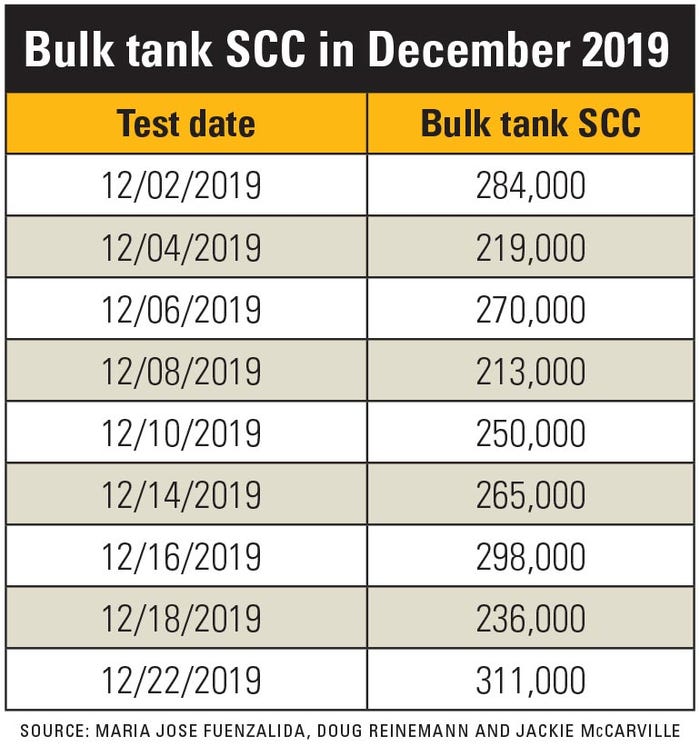September 18, 2020

In November 2019, we received a call from a farm with concerns about the level of mastitis in its herd. The farm installed two automatic milking systems (robotic milkers) about three years prior, at which time a new three-row, sand-bedded freestall barn with drive-through feeding was also built.
Mastitis detection methods consisted of identifying cows with high milk conductivity followed by manual striping and observation of any visible signs of abnormal milk or udder inflammation. The producers were not initially conducting monthly individual somatic cell count testing because they did not have access to an automated sample collection device. A year ago, they were able to locate a sample device and started measuring SCC of the whole herd monthly.
They reported that several cows with subclinical mastitis (greater than or equal to 200,000 somatic cells per milliliter) did not register high conductivity levels. In December 2019, the farmer reached out to Extension to help investigate this mastitis concern.
Milk quality situation
Following is a summary of the farm’s milk quality:
SCC. Bulk tank SCC was consistently greater than 200,000 cells per milliliter since December 2017. Data for December 2019 is depicted in the table.

Bacteria present. The farmer sent bulk-tank milk samples for microbiological diagnosis. These cultures identified the presence of Staphylococcus aureus and Streptococcus agalactiae, meaning the herd had one or more cows infected with contagious pathogens. The total number of environmental bacteria was also identified as an issue.
SM prevalence. We estimated the prevalence of subclinical mastitis (SM) from individual cow SCC tests as 24% to 49% of cows between September and December 2019. During this period 26%, of cows experienced chronic SM (two consecutive SCC tests ≥ 200,000 cells/mL). Goals for the prevalence of SM is less than 15% of cows, and for chronic SM, less than 5% of cows.
We concluded that there were issues with both contagious and environmental mastitis and scheduled a farm visit to gather more information.
Farm visit and recommendations
We conducted the following activities during the farm visit:
udder hygiene scoring of all cows using the system recommended by Dr. Pamela Ruegg
performed California Mastitis Test on all quarters of cows identified as having SM and chronic SM
collected milk samples from CMT-positive quarters
sent quarter milk samples to Wisconsin Veterinary Diagnostic Laboratory for microbiological analyses
Quarter microbiology indicated that 76% of samples were positive for bacterial growth, and 46% of cows sampled were infected with contagious pathogens.
We concluded that udder hygiene could be improved, and that both environmental and contagious mastitis were prevalent in the herd. We made the following recommenations:
Monitor. Implement a continuous ongoing monitoring system for bulk tank milk and individual cows to identify the types and prevalence of mastitis in the herd.
Test. Develop a sampling strategy to test all cows to identify cows positive to contagious pathogens.
Cull. Isolate and cull cows positive to Staphylococcus aureus.
Treat. Develop an antimicrobial treatment protocol for cows positive to Streptococcus agalactiae. In the meantime, these cows need to be isolated.
Maintain. Keep stalls clean and dry — and thereby keep udders and teats clean. This is the first line of defense for environmental mastitis. Periodic udder hygiene scoring is a good way to assess the effectiveness of stall and bedding maintenance.
Isolate. Some automatic milking system barn designs make it difficult to create isolated groups of cows, should the need arise. Consider this when designing an AMS barn.
Sanitize. Pre- and post-milking sanitization can be performed with AMS technology to reduce the transfer of contagious mastitis pathogens. It is still necessary to monitor the herd to detect the presence of contagious pathogens.
Fuenzalida is the Extension bilingual dairy and livestock educator in Dane County, Wis. Doug Reinemann, University of Wisconsin-Madison biological systems engineering professor, and Jackie McCarville, Extension ag educator in Green County, Wis., contributed to this column. This column is provided by the University of Wisconsin-Extension Dairy Team.
You May Also Like




